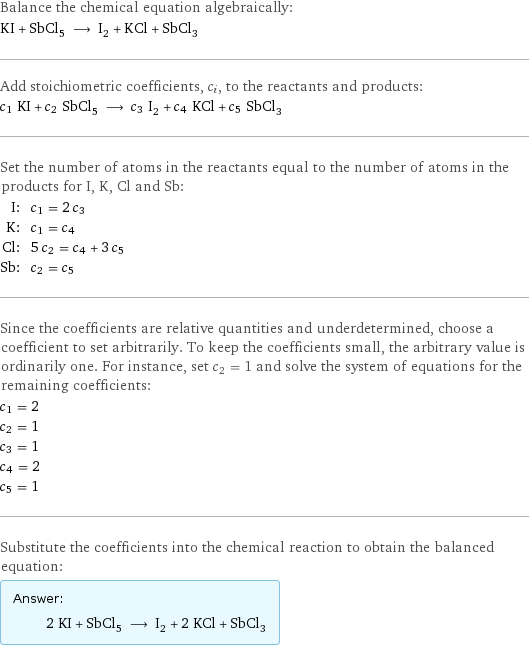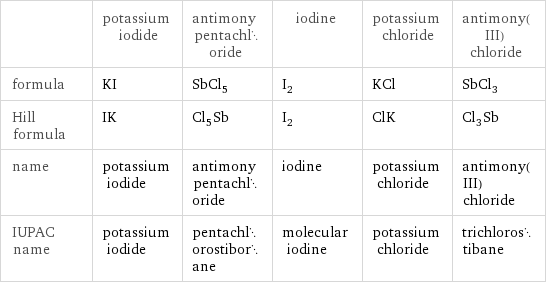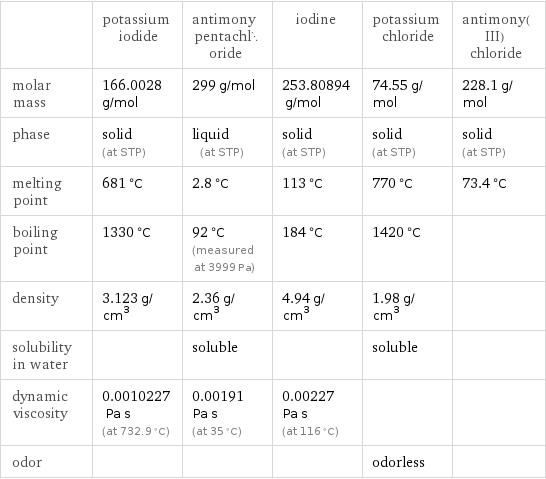Input interpretation

KI potassium iodide + SbCl_5 antimony pentachloride ⟶ I_2 iodine + KCl potassium chloride + SbCl_3 antimony(III) chloride
Balanced equation

Balance the chemical equation algebraically: KI + SbCl_5 ⟶ I_2 + KCl + SbCl_3 Add stoichiometric coefficients, c_i, to the reactants and products: c_1 KI + c_2 SbCl_5 ⟶ c_3 I_2 + c_4 KCl + c_5 SbCl_3 Set the number of atoms in the reactants equal to the number of atoms in the products for I, K, Cl and Sb: I: | c_1 = 2 c_3 K: | c_1 = c_4 Cl: | 5 c_2 = c_4 + 3 c_5 Sb: | c_2 = c_5 Since the coefficients are relative quantities and underdetermined, choose a coefficient to set arbitrarily. To keep the coefficients small, the arbitrary value is ordinarily one. For instance, set c_2 = 1 and solve the system of equations for the remaining coefficients: c_1 = 2 c_2 = 1 c_3 = 1 c_4 = 2 c_5 = 1 Substitute the coefficients into the chemical reaction to obtain the balanced equation: Answer: | | 2 KI + SbCl_5 ⟶ I_2 + 2 KCl + SbCl_3
Structures

+ ⟶ + +
Names

potassium iodide + antimony pentachloride ⟶ iodine + potassium chloride + antimony(III) chloride
Equilibrium constant
![Construct the equilibrium constant, K, expression for: KI + SbCl_5 ⟶ I_2 + KCl + SbCl_3 Plan: • Balance the chemical equation. • Determine the stoichiometric numbers. • Assemble the activity expression for each chemical species. • Use the activity expressions to build the equilibrium constant expression. Write the balanced chemical equation: 2 KI + SbCl_5 ⟶ I_2 + 2 KCl + SbCl_3 Assign stoichiometric numbers, ν_i, using the stoichiometric coefficients, c_i, from the balanced chemical equation in the following manner: ν_i = -c_i for reactants and ν_i = c_i for products: chemical species | c_i | ν_i KI | 2 | -2 SbCl_5 | 1 | -1 I_2 | 1 | 1 KCl | 2 | 2 SbCl_3 | 1 | 1 Assemble the activity expressions accounting for the state of matter and ν_i: chemical species | c_i | ν_i | activity expression KI | 2 | -2 | ([KI])^(-2) SbCl_5 | 1 | -1 | ([SbCl5])^(-1) I_2 | 1 | 1 | [I2] KCl | 2 | 2 | ([KCl])^2 SbCl_3 | 1 | 1 | [SbCl3] The equilibrium constant symbol in the concentration basis is: K_c Mulitply the activity expressions to arrive at the K_c expression: Answer: | | K_c = ([KI])^(-2) ([SbCl5])^(-1) [I2] ([KCl])^2 [SbCl3] = ([I2] ([KCl])^2 [SbCl3])/(([KI])^2 [SbCl5])](../image_source/9a0fdf2314c8929e6127b8afe64d899c.png)
Construct the equilibrium constant, K, expression for: KI + SbCl_5 ⟶ I_2 + KCl + SbCl_3 Plan: • Balance the chemical equation. • Determine the stoichiometric numbers. • Assemble the activity expression for each chemical species. • Use the activity expressions to build the equilibrium constant expression. Write the balanced chemical equation: 2 KI + SbCl_5 ⟶ I_2 + 2 KCl + SbCl_3 Assign stoichiometric numbers, ν_i, using the stoichiometric coefficients, c_i, from the balanced chemical equation in the following manner: ν_i = -c_i for reactants and ν_i = c_i for products: chemical species | c_i | ν_i KI | 2 | -2 SbCl_5 | 1 | -1 I_2 | 1 | 1 KCl | 2 | 2 SbCl_3 | 1 | 1 Assemble the activity expressions accounting for the state of matter and ν_i: chemical species | c_i | ν_i | activity expression KI | 2 | -2 | ([KI])^(-2) SbCl_5 | 1 | -1 | ([SbCl5])^(-1) I_2 | 1 | 1 | [I2] KCl | 2 | 2 | ([KCl])^2 SbCl_3 | 1 | 1 | [SbCl3] The equilibrium constant symbol in the concentration basis is: K_c Mulitply the activity expressions to arrive at the K_c expression: Answer: | | K_c = ([KI])^(-2) ([SbCl5])^(-1) [I2] ([KCl])^2 [SbCl3] = ([I2] ([KCl])^2 [SbCl3])/(([KI])^2 [SbCl5])
Rate of reaction
![Construct the rate of reaction expression for: KI + SbCl_5 ⟶ I_2 + KCl + SbCl_3 Plan: • Balance the chemical equation. • Determine the stoichiometric numbers. • Assemble the rate term for each chemical species. • Write the rate of reaction expression. Write the balanced chemical equation: 2 KI + SbCl_5 ⟶ I_2 + 2 KCl + SbCl_3 Assign stoichiometric numbers, ν_i, using the stoichiometric coefficients, c_i, from the balanced chemical equation in the following manner: ν_i = -c_i for reactants and ν_i = c_i for products: chemical species | c_i | ν_i KI | 2 | -2 SbCl_5 | 1 | -1 I_2 | 1 | 1 KCl | 2 | 2 SbCl_3 | 1 | 1 The rate term for each chemical species, B_i, is 1/ν_i(Δ[B_i])/(Δt) where [B_i] is the amount concentration and t is time: chemical species | c_i | ν_i | rate term KI | 2 | -2 | -1/2 (Δ[KI])/(Δt) SbCl_5 | 1 | -1 | -(Δ[SbCl5])/(Δt) I_2 | 1 | 1 | (Δ[I2])/(Δt) KCl | 2 | 2 | 1/2 (Δ[KCl])/(Δt) SbCl_3 | 1 | 1 | (Δ[SbCl3])/(Δt) (for infinitesimal rate of change, replace Δ with d) Set the rate terms equal to each other to arrive at the rate expression: Answer: | | rate = -1/2 (Δ[KI])/(Δt) = -(Δ[SbCl5])/(Δt) = (Δ[I2])/(Δt) = 1/2 (Δ[KCl])/(Δt) = (Δ[SbCl3])/(Δt) (assuming constant volume and no accumulation of intermediates or side products)](../image_source/6c81a7bc648c69f2fbb17815575a77f2.png)
Construct the rate of reaction expression for: KI + SbCl_5 ⟶ I_2 + KCl + SbCl_3 Plan: • Balance the chemical equation. • Determine the stoichiometric numbers. • Assemble the rate term for each chemical species. • Write the rate of reaction expression. Write the balanced chemical equation: 2 KI + SbCl_5 ⟶ I_2 + 2 KCl + SbCl_3 Assign stoichiometric numbers, ν_i, using the stoichiometric coefficients, c_i, from the balanced chemical equation in the following manner: ν_i = -c_i for reactants and ν_i = c_i for products: chemical species | c_i | ν_i KI | 2 | -2 SbCl_5 | 1 | -1 I_2 | 1 | 1 KCl | 2 | 2 SbCl_3 | 1 | 1 The rate term for each chemical species, B_i, is 1/ν_i(Δ[B_i])/(Δt) where [B_i] is the amount concentration and t is time: chemical species | c_i | ν_i | rate term KI | 2 | -2 | -1/2 (Δ[KI])/(Δt) SbCl_5 | 1 | -1 | -(Δ[SbCl5])/(Δt) I_2 | 1 | 1 | (Δ[I2])/(Δt) KCl | 2 | 2 | 1/2 (Δ[KCl])/(Δt) SbCl_3 | 1 | 1 | (Δ[SbCl3])/(Δt) (for infinitesimal rate of change, replace Δ with d) Set the rate terms equal to each other to arrive at the rate expression: Answer: | | rate = -1/2 (Δ[KI])/(Δt) = -(Δ[SbCl5])/(Δt) = (Δ[I2])/(Δt) = 1/2 (Δ[KCl])/(Δt) = (Δ[SbCl3])/(Δt) (assuming constant volume and no accumulation of intermediates or side products)
Chemical names and formulas

| potassium iodide | antimony pentachloride | iodine | potassium chloride | antimony(III) chloride formula | KI | SbCl_5 | I_2 | KCl | SbCl_3 Hill formula | IK | Cl_5Sb | I_2 | ClK | Cl_3Sb name | potassium iodide | antimony pentachloride | iodine | potassium chloride | antimony(III) chloride IUPAC name | potassium iodide | pentachlorostiborane | molecular iodine | potassium chloride | trichlorostibane
Substance properties

| potassium iodide | antimony pentachloride | iodine | potassium chloride | antimony(III) chloride molar mass | 166.0028 g/mol | 299 g/mol | 253.80894 g/mol | 74.55 g/mol | 228.1 g/mol phase | solid (at STP) | liquid (at STP) | solid (at STP) | solid (at STP) | solid (at STP) melting point | 681 °C | 2.8 °C | 113 °C | 770 °C | 73.4 °C boiling point | 1330 °C | 92 °C (measured at 3999 Pa) | 184 °C | 1420 °C | density | 3.123 g/cm^3 | 2.36 g/cm^3 | 4.94 g/cm^3 | 1.98 g/cm^3 | solubility in water | | soluble | | soluble | dynamic viscosity | 0.0010227 Pa s (at 732.9 °C) | 0.00191 Pa s (at 35 °C) | 0.00227 Pa s (at 116 °C) | | odor | | | | odorless |
Units
